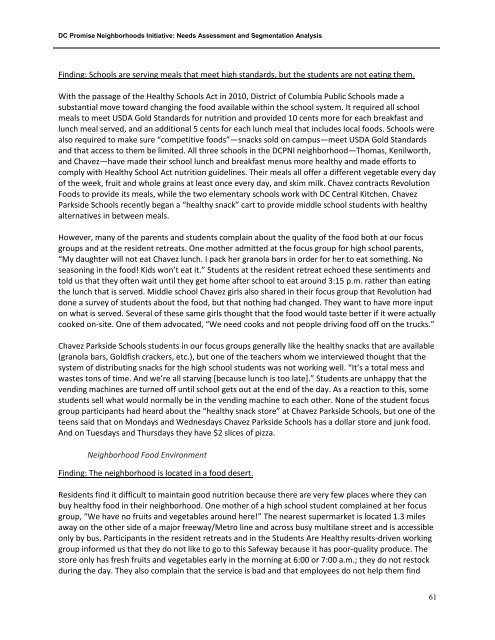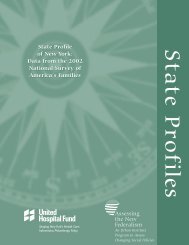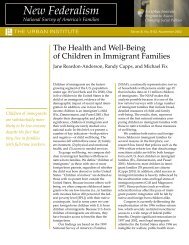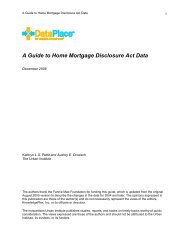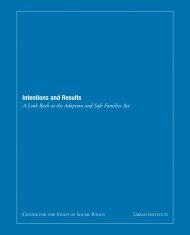DC Promise Neighborhood Initiative: Needs ... - Urban Institute
DC Promise Neighborhood Initiative: Needs ... - Urban Institute
DC Promise Neighborhood Initiative: Needs ... - Urban Institute
Create successful ePaper yourself
Turn your PDF publications into a flip-book with our unique Google optimized e-Paper software.
<strong>DC</strong> <strong>Promise</strong> <strong>Neighborhood</strong>s <strong>Initiative</strong>: <strong>Needs</strong> Assessment and Segmentation AnalysisFinding: Schools are serving meals that meet high standards, but the students are not eating them.With the passage of the Healthy Schools Act in 2010, District of Columbia Public Schools made asubstantial move toward changing the food available within the school system. It required all schoolmeals to meet USDA Gold Standards for nutrition and provided 10 cents more for each breakfast andlunch meal served, and an additional 5 cents for each lunch meal that includes local foods. Schools werealso required to make sure “competitive foods”—snacks sold on campus—meet USDA Gold Standardsand that access to them be limited. All three schools in the <strong>DC</strong>PNI neighborhood—Thomas, Kenilworth,and Chavez—have made their school lunch and breakfast menus more healthy and made efforts tocomply with Healthy School Act nutrition guidelines. Their meals all offer a different vegetable every dayof the week, fruit and whole grains at least once every day, and skim milk. Chavez contracts RevolutionFoods to provide its meals, while the two elementary schools work with <strong>DC</strong> Central Kitchen. ChavezParkside Schools recently began a “healthy snack” cart to provide middle school students with healthyalternatives in between meals.However, many of the parents and students complain about the quality of the food both at our focusgroups and at the resident retreats. One mother admitted at the focus group for high school parents,“My daughter will not eat Chavez lunch. I pack her granola bars in order for her to eat something. Noseasoning in the food! Kids won’t eat it.” Students at the resident retreat echoed these sentiments andtold us that they often wait until they get home after school to eat around 3:15 p.m. rather than eatingthe lunch that is served. Middle school Chavez girls also shared in their focus group that Revolution haddone a survey of students about the food, but that nothing had changed. They want to have more inputon what is served. Several of these same girls thought that the food would taste better if it were actuallycooked on-site. One of them advocated, “We need cooks and not people driving food off on the trucks.”Chavez Parkside Schools students in our focus groups generally like the healthy snacks that are available(granola bars, Goldfish crackers, etc.), but one of the teachers whom we interviewed thought that thesystem of distributing snacks for the high school students was not working well. “It’s a total mess andwastes tons of time. And we’re all starving [because lunch is too late].” Students are unhappy that thevending machines are turned off until school gets out at the end of the day. As a reaction to this, somestudents sell what would normally be in the vending machine to each other. None of the student focusgroup participants had heard about the “healthy snack store” at Chavez Parkside Schools, but one of theteens said that on Mondays and Wednesdays Chavez Parkside Schools has a dollar store and junk food.And on Tuesdays and Thursdays they have $2 slices of pizza.<strong>Neighborhood</strong> Food EnvironmentFinding: The neighborhood is located in a food desert.Residents find it difficult to maintain good nutrition because there are very few places where they canbuy healthy food in their neighborhood. One mother of a high school student complained at her focusgroup, “We have no fruits and vegetables around here!” The nearest supermarket is located 1.3 milesaway on the other side of a major freeway/Metro line and across busy multilane street and is accessibleonly by bus. Participants in the resident retreats and in the Students Are Healthy results-driven workinggroup informed us that they do not like to go to this Safeway because it has poor-quality produce. Thestore only has fresh fruits and vegetables early in the morning at 6:00 or 7:00 a.m.; they do not restockduring the day. They also complain that the service is bad and that employees do not help them find61


